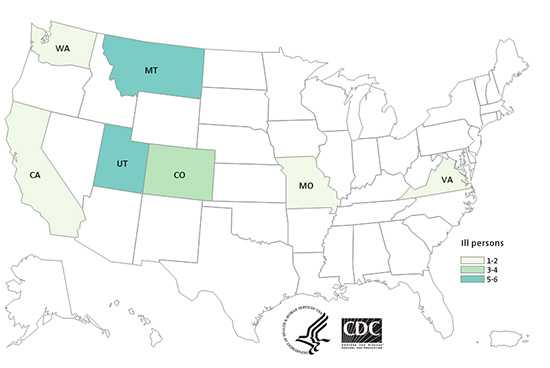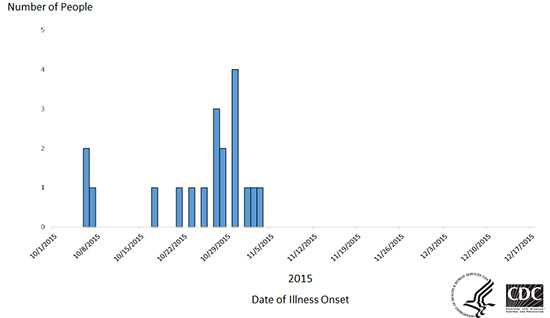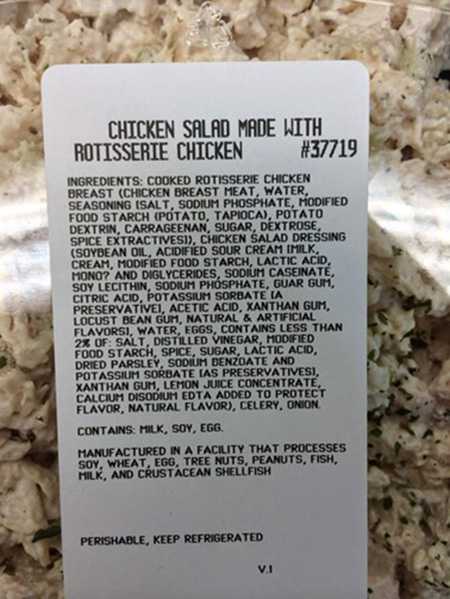Multistate Outbreak of Shiga toxin-producing Escherichia coli O157:H7 Infections Linked to Costco Rotisserie Chicken Salad (Final Update)
Posted December 22, 2015 11:00 AM ET
This outbreak appears to be over. However, E. coli is still an important cause of human illness in the United States. More information about E. coli, and steps people can take to reduce their risk of infection, can be found on the CDC E. coli web page.
Highlights
- Read the Recall & Advice to Consumers, Restaurants, and Retailers »
- This outbreak appears to be over. The most recent illness in this outbreak reported to CDC started on November 3, 2015.
- CDC, the U.S. Food and Drug Administration (FDA), the U.S. Department of Agriculture Food Safety and Inspection Service, and public health officials in several states investigated an outbreak of Shiga toxin-producing Escherichia coli O157:H7 (STEC O157:H7) infections.
- Nineteen people infected with the outbreak strain of STEC O157:H7 were reported from seven states. Most illnesses were reported from the western United States.
- Five ill people were hospitalized, and two developed hemolytic uremic syndrome, a type of kidney failure. No deaths were reported.
- The epidemiologic evidence collected during this investigation suggested that rotisserie chicken salad made and sold in Costco Wholesale stores in several states was the likely source of this outbreak.
- Fourteen (88%) of 16 people purchased or ate rotisserie chicken salad from Costco in the week before illness started.
- On November 20, 2015, Costco reported to public health officials that the company had voluntarily removed all remaining rotisserie chicken salad from all stores in the United States.
- On November 26, 2015, out of an abundance of caution, Taylor Farms Pacific, Inc., voluntarily recalled the celery and onion diced blend used in the Costco chicken salad and many other products containing celery, because they might be contaminated with E. coli O157:H7.
- Consumers, restaurants, and retailers should not eat, serve, or sell any of the products recalled by Taylor Farms Pacific, Inc.
- The FDA conducted a traceback investigation of the FDA regulated ingredients used in the chicken salad to try to determine which ingredient was linked to illness. However, the traceback investigation did not identify a common source of contamination.
Outbreak Summary
Introduction
CDC, the U.S. Food and Drug Administration (FDA), the U.S. Department of Agriculture Food Safety and Inspection Service, and public health officials in several states investigated an outbreak of Shiga toxin-producing Escherichia coli O157:H7 (STEC O157:H7) infections.
Public health investigators used the PulseNet system to identify illnesses that were part of this outbreak. PulseNet, the national subtyping network of public health and food regulatory agency laboratories, is coordinated by CDC. DNA fingerprinting is performed on E. coli bacteria isolated from ill people by using a technique called pulsed-field gel electrophoresis, or PFGE. PulseNet manages a national database of these DNA fingerprints to identify possible outbreaks.
One DNA fingerprint (outbreak strain) was included in this investigation. A total of 19 people infected with the outbreak strain of Shiga toxin-producing STEC O157:H7 were reported from seven states. The majority of illnesses were reported from the western United States. The number of ill people reported from each state was as follows: California (1), Colorado (4), Missouri (1), Montana (6), Utah (5), Virginia (1), and Washington (1).
Among people for whom information was available, illnesses started on dates ranging from October 6, 2015 to November 3, 2015. Ill people ranged in age from 5 years to 84, with a median age of 18. Fifty-seven percent of ill people were female. Five (29%) people were hospitalized, and two people developed hemolytic uremic syndrome, a type of kidney failure. No deaths were reported.
Investigation of the Outbreak
The epidemiologic evidence collected during this investigation suggested that rotisserie chicken salad made and sold in Costco stores was the likely source of this outbreak.
State and local public health officials interviewed ill people to obtain information about foods they might have eaten and other exposures in the week before their illness started. Fourteen (88%) of 16 people purchased or ate rotisserie chicken salad from Costco.
On November 20, 2015, Costco reported to public health officials that the company had removed all remaining rotisserie chicken salad from all stores in the United States. This voluntary action taken by Costco may have prevented additional illnesses. Costco also worked in collaboration with public health officials during the investigation by providing records and information related to ingredient suppliers to try to determine the source of the outbreak.
The Montana Public Health Laboratory tested a sample of celery and onion diced blend produced by Taylor Farms Pacific, Inc. and collected from a Costco store in Montana. Preliminary results indicated the presence of E. coli O157:H7. This product was used to make the Costco rotisserie chicken salad eaten by ill people in this outbreak. According to the FDA, further laboratory analysis was unable to confirm the presence of E. coli O157:H7 in the sample of celery and onion diced blend.
As a result of the preliminary laboratory results and out of an abundance of caution, on November 26, 2015, Taylor Farms Pacific, Inc. voluntarily recalled the celery and onion diced blend and many other products containing celery because they might be contaminated with E. coli O157:H7.
The FDA conducted a traceback investigation of the FDA regulated ingredients used in the chicken salad to try to determine which ingredient was linked to illness. However, the traceback investigation did not identify a common source of contamination.
This outbreak appears to be over. However, E. coli is still an important cause of human illness in the United States. More information about E. coli, and steps people can take to reduce their risk of infection, can be found on the CDC E. coli General Information web page.
December 8, 2015
Investigation Update
According to the U.S. Food and Drug Administration, further laboratory analysis was unable to confirm the presence of E. coli O157:H7 in a sample of celery and onion diced blend produced by Taylor Farms Pacific, Inc. that was collected from a Costco store in Montana. The Montana Public Health Laboratory initially tested the sample and preliminary results indicated the presence of E. coli O157:H7. The preliminary test performed on the sample was a polymerase chain reaction (PCR) test, which is commonly used to rapidly screen for the presence of bacterial DNA.
No additional illnesses in this outbreak have been reported to CDC since November 23. CDC and state and local public health partners are continuing laboratory surveillance through PulseNet to identify any additional ill persons and to interview them.
The ongoing investigation is working to identify which specific ingredient in the chicken salad is linked to illness. The celery and onion diced blend has not been ruled out as a source of the outbreak. Updates will be provided when more information is available.
November 27, 2015
Investigation Update
The Montana Public Health Laboratory tested a sample of celery and onion diced blend collected from a Costco location. Preliminary results indicated the presence of E. coli O157:H7. Laboratory testing is ongoing to isolate the E. coli bacteria and then determine the DNA fingerprint. The celery and onion diced blend was supplied to Costco by Taylor Farms Pacific, Inc. and was used to make the Costco rotisserie chicken salad eaten by ill people in this outbreak.
As a result of the preliminary laboratory results, on November 26, 2015, Taylor Farms Pacific, Inc., voluntarily recalled multiple products containing celery because they may be contaminated with E. coli O157:H7.
CDC and state and local public health partners are continuing laboratory surveillance through PulseNet to identify any additional ill persons and to interview them.
This investigation is ongoing. Updates will be provided when more information is available.
November 24, 2015
Initial Announcement
CDC, the U.S. Food and Drug Administration, the U.S. Department of Agriculture Food Safety and Inspection Service, and public health officials in several states are investigating an outbreak of Shiga toxin-producing Escherichia coli O157:H7 (STEC O157:H7) infections.
Public health investigators are using the PulseNet system to identify illnesses that may be part of this outbreak. PulseNet, the national subtyping network of public health and food regulatory agency laboratories, is coordinated by CDC. DNA "fingerprinting" is performed on E. coli bacteria isolated from ill people by using a technique called pulsed-field gel electrophoresis, or PFGE. PulseNet manages a national database of these DNA fingerprints to identify possible outbreaks.
One DNA fingerprint (outbreak strain) is included in this investigation. A total of 19 people infected with the outbreak strain of Shiga toxin-producing STEC O157:H7 have been reported from 7 states. The majority of illnesses have been reported from states in the western United States. The number of ill people reported from each state is as follows: California (1), Colorado (4), Missouri (1), Montana (6), Utah (5), Virginia (1), and Washington (1).
Among people for whom information is available, illnesses started on dates ranging from October 6, 2015 to November 3, 2015. Ill people range in age from 5 years to 84, with a median age of 18. Fifty-seven percent of ill people are female. Five (29%) people reported being hospitalized, and two people developed hemolytic uremic syndrome (HUS), a type of kidney failure. No deaths have been reported.
This outbreak can be illustrated with a chart showing the number of people who became ill each day. This chart is called an epidemic curve or epi curve. Illnesses that occurred after November 10, 2015, might not be reported yet due to the time it takes between when a person becomes ill and when the illness is reported. This takes an average of 2 to 3 weeks. Please see the Timeline for Reporting Cases of E. coli Infection for more details.
CDC and state and local public health partners are continuing laboratory surveillance through PulseNet to identify additional ill persons and to interview them.
Investigation of the Outbreak
The epidemiologic evidence available to investigators at this time suggests that rotisserie chicken salad made and sold in Costco stores is a likely source of this outbreak. The ongoing investigation has not identified what specific ingredient in the chicken salad is linked to illness.
State and local public health officials are interviewing ill people to obtain information about foods they might have eaten and other exposures in the week before their illness started. Fourteen (88%) of 16 people purchased or ate rotisserie chicken salad from Costco.
On November 20, 2015, Costco reported to public health officials that the company had removed all remaining rotisserie chicken salad from all stores in the United States and stopped further production of the product until further notice.
Updates will be provided when more information is available.
More Information
- Page last reviewed: November 27, 2015
- Page last updated: December 22, 2015
- Content source:


 ShareCompartir
ShareCompartir


